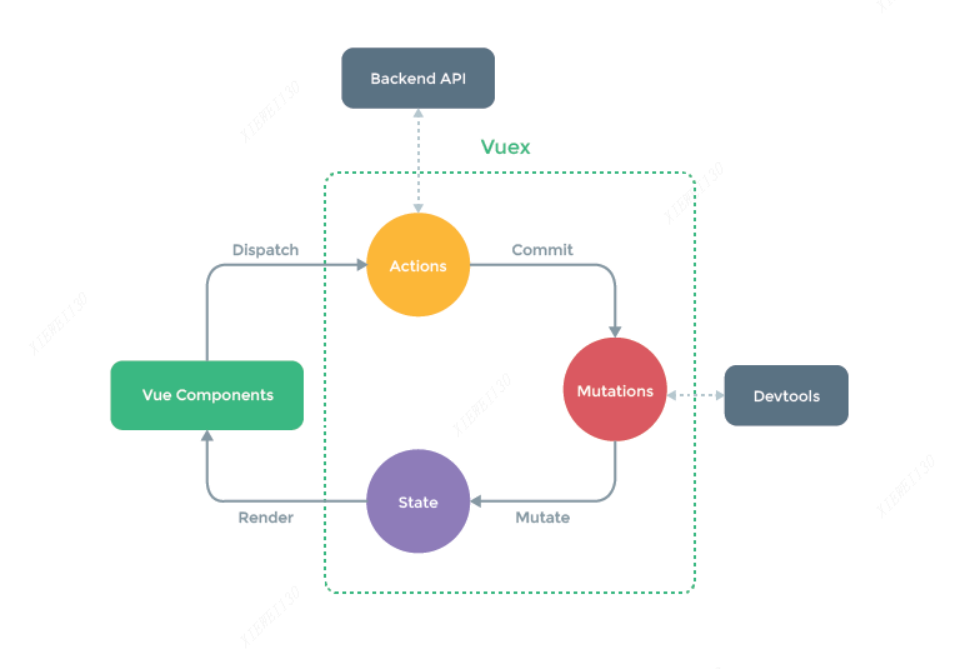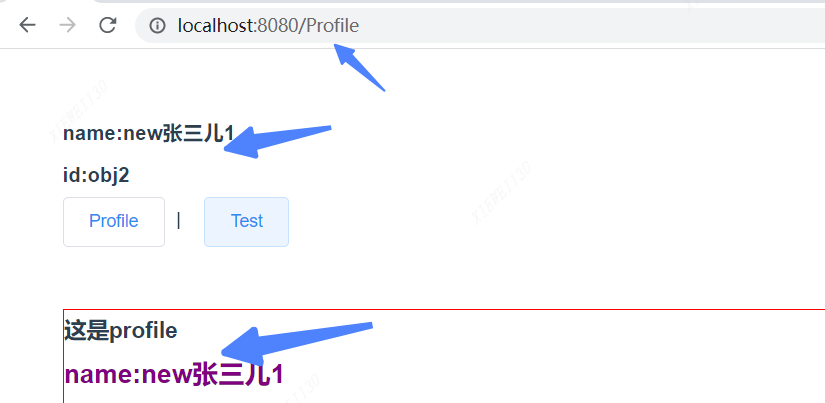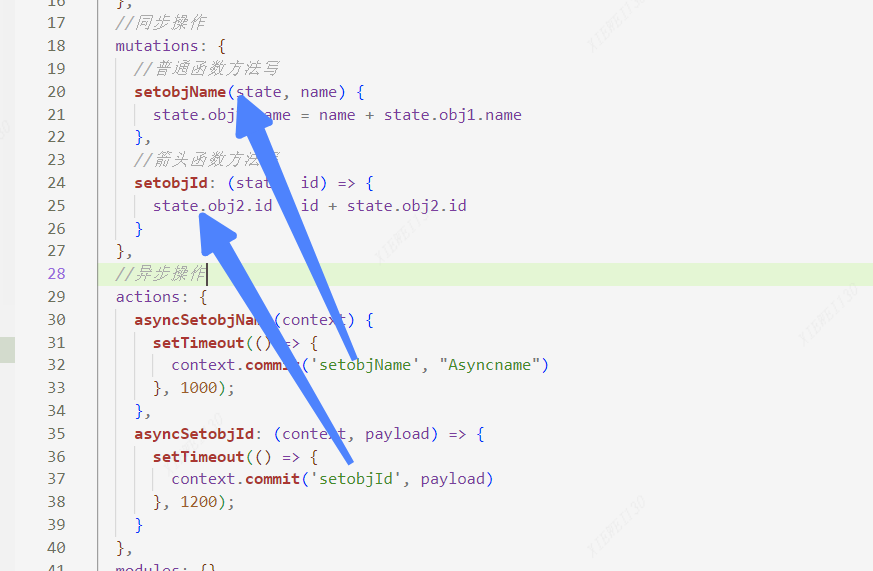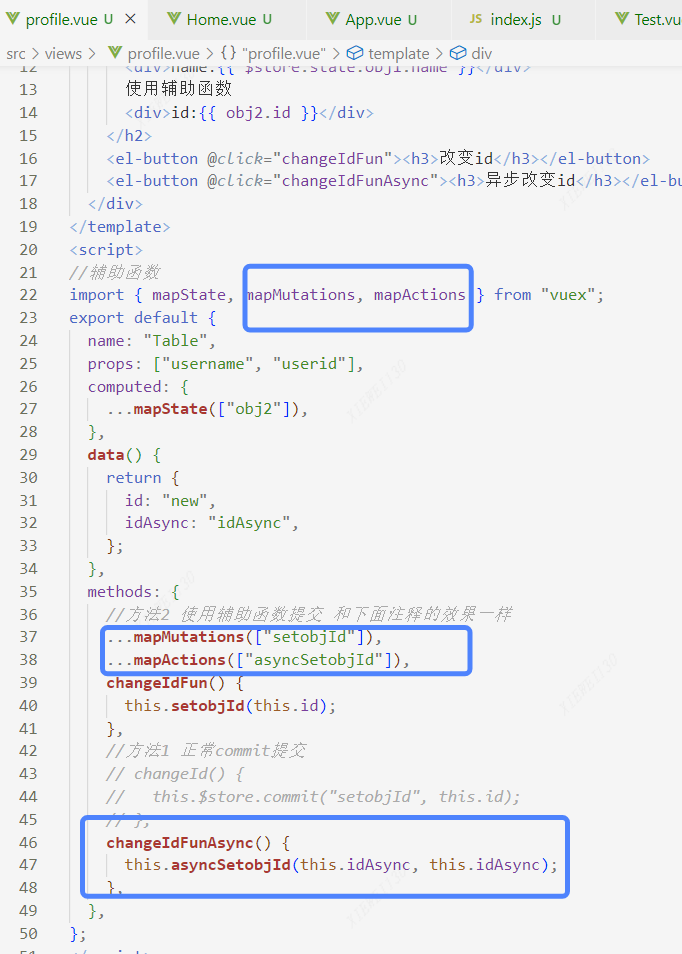vuex状态管理(一)原理以及使用注意事项_无围之解的博客-CSDN博客

原理上一篇文章已经写了
1 本文默认首先项目已经安装了vuex,没有安装的参考官网安装一下
2 先看看正常的结构
import Vue from 'vue'
import Vuex from 'vuex'
Vue.use(Vuex)
export default new Vuex.Store({
//定义数据
state: {
},
//同步操作
mutations: {
},
//异步操作
actions: {
},
modules: {}
})3 这几个主要的名词解释
3.1 state中主要是定义公共使用的数据,对象或这单个字符串,数组等等。
3.2 mutations 主要是数据的更改状态提交提交。只有这一种方式提交修改的数据才能追踪。
当你修改数据时,就需要通过commit提交, mutations会记录它的修改动作,便于跟踪管理。
3.3 actions主要时异步操作获取更改数据,但是也要最后通过dispatch就行数据提交,最终还是要通过mutations才能提交数据
3.4 mapState, mapMutations, mapActions 这些辅助函数,写法简单,用起来方便
3.5 页面获取数据 $store.state.obj1
4 下面看实例
4.1先在state中写2个数据
state: {
//直接使用
obj1: {
name: "张三儿1",
id: "obj1"
},
//辅助函数
obj2: {
name: "张三儿2",
id: "obj2"
}
},4.2然后mutations中写两个修改数据的方法
state.obj1.name = name + state.obj1.name
state.obj1.name就可以拿到state中的要操作的数据,同时可以传递一个参数name(或者多个参数)
mutations: {
//普通函数方法写
setobjName(state, name) {
state.obj1.name = name + state.obj1.name
},
},4.3 然后去页面修改 app.vue, test.vue, profile.vue页面 分别获取obj1.name,和obj2的属性id 看下图页面渲染效果
<h2>
<div>name:{
{ $store.state.obj1.name }}</div>
<div>id:{
{ $store.state.obj2.id }}</div>
</h2>我们看test.vue页面

4.4此时 我们在test.vue写一个button按钮改变修改数据
<el-button @click="changeName"><h3>改变name</h3></el-button>然后我们写方法调用 this.$store.commit("AAAA", BBBB);
AAAA就是mutations中要用的方法名,BBBB是参数

export default {
data() {
return {
name: "new",
};
},
methods: {
changeName() {
this.$store.commit("setobjName", this.name);
},
},
};点击一下,看效果 会发现app.vue, test.vue, profile.vue 三个页面的都改变了,成了new张三儿1,是不是很神奇

4.5 同样可以使用辅助函数写。我们在profile.vue页面写一个按钮
<el-button @click="changeIdFun"><h3>改变id</h3></el-button>此时我们页面引入辅助函数
import { mapState, mapMutations} from "vuex";然后计算属性获取
computed: {
...mapState(["obj2"]),
},我们页面获取数据可以写成这样
<h2>
使用辅助函数
<div>id:{
{ obj2.id }}</div>
</h2><script>
//辅助函数
import { mapState, mapMutations} from "vuex";
export default {
name: "Table",
computed: {
...mapState(["obj2"]),
},
data() {
return {
id: "new",
};
},
methods: {
//方法2 使用辅助函数提交 和下面注释的效果一样
...mapMutations(["setobjId"]),
changeIdFun() {
this.setobjId(this.id);
},
},
};
</script>5 同样异步操作经常是调用接口获取数据需要耗时,我们需要等待,追踪状态
方法asyncSetobjName,隔1秒再修改数据,传递参数Asyncname
方法asyncSetobjId 隔1.2秒再修改数据,传递动态参数
//异步操作
actions: {
asyncSetobjName(context) {
setTimeout(() => {
context.commit('setobjName', "Asyncname")
}, 1000);
},
asyncSetobjId: (context, payload) => {
setTimeout(() => {
context.commit('setobjId', payload)
}, 1200);
}
},会发现 context.commit('setobjName', "Asyncname")时候的方法还是mutations里面的同步方法!

同样页面提交时候 this.$store.dispatch("XXXX");
test.vue页面

changeNameAsync() {
this.$store.dispatch("asyncSetobjName");
},也可以使用辅助函数操

使用的详细教程文档结构
使用的详细教程文档结构
使用的详细教程文档结构

1 store.js文档的结构
import Vue from 'vue'
import Vuex from 'vuex'
Vue.use(Vuex)
export default new Vuex.Store({
state: {
//直接使用
obj1: {
name: "张三儿1",
id: "obj1"
},
//辅助函数
obj2: {
name: "张三儿2",
id: "obj2"
}
},
//同步操作
mutations: {
//普通函数方法写
setobjName(state, name) {
state.obj1.name = name + state.obj1.name
},
//箭头函数方法写
setobjId: (state, id) => {
state.obj2.id = id + state.obj2.id
}
},
//异步操作
actions: {
asyncSetobjName(context) {
setTimeout(() => {
context.commit('setobjName', "Asyncname")
}, 1000);
},
asyncSetobjId: (context, payload) => {
setTimeout(() => {
context.commit('setobjId', payload)
}, 1200);
}
},
modules: {}
})2 路由里面核心代码组件 Home, Test,Profile三个组件页面(也可以不用一下代码。自己写三个路由组件)

import Vue from 'vue'
import VueRouter from 'vue-router'
import Home from '../views/Home.vue'
import Login from '../views/login.vue'
import Footer from '../views/footer.vue'
Vue.use(VueRouter)
const VueRouterPush = VueRouter.prototype.push
VueRouter.prototype.push = function push(to) {
return VueRouterPush.call(this, to).catch(err => err)
}
const routes = [{
path: '/',
name: 'Home',
components: {
default: Home,
footerName: Footer
}
},
{
path: '/Login',
name: 'Login',
components: {
default: Login,
}
},
{
path: '/Test',
name: 'Test',
meta: {
title: "是否有权限",
transition: "abcd"
},
components: {
default: () => import('../views/Test.vue'),
footerName: Footer
},
props: {
default: route => {
return route.query.search
},
footerName: {
footerdata: "正版"
}
},
beforeEnter: (to, from, next) => {
if (to.meta.title) {
console.log('meta后执行', to.meta.title)
}
next()
}
}, {
path: '/Profile',
name: 'Profile',
components: {
default: () => import('../views/profile.vue'),
footerName: Footer
},
props: {
default: true,
footerName: {
footerdata: "正版"
}
}
},
{
path: '/:all',
name: 'Router404',
component: () => import('../views/Router404.vue')
}
]
const router = new VueRouter({
mode: 'history',
base: process.env.BASE_URL,
routes
})
let flag = false;
let pathName = '';
router.beforeEach((to, from, next) => {
if (to.meta.title) {
console.log('meta先执行')
}
flag = localStorage.getItem('userToken') ? true : false
if (flag) {
if (to.name === 'Login') {
next('/')
} else if (to.name === 'Home' && pathName) {
next(pathName)
} else {
next()
}
} else {
if (to.name === 'Login') {
next()
} else {
if (to.path === '/Profile') {
pathName = to.path
}
next('/Login')
}
}
})
export default router3 App.vue
<template>
<div id="app" style="margin: 50px; line-height: 34px; width: 800px">
<h3>
<div>name:{
{ $store.state.obj1.name }}</div>
<div>id:{
{ $store.state.obj2.id }}</div>
</h3>
<el-button> <router-link to="/Profile">Profile</router-link></el-button> 丨
<el-button> <router-link to="/Test">Test</router-link></el-button>
<router-view v-slot="{ Component }">
<transition :name="route.meta.transition || 'fade'">
<component :is="Component" />
</transition>
</router-view>
<router-view name="footerName"></router-view>
</div>
</template>4 profile.vue
<template>
<div
style="
margin-top: 50px;
line-height: 34px;
width: 800px;
border: 1px solid red;
"
>
<h3>这是profile</h3>
<h2>
<div>name:{
{ $store.state.obj1.name }}</div>
使用辅助函数
<div>id:{
{ obj2.id }}</div>
</h2>
<el-button @click="changeIdFun"><h3>改变id</h3></el-button>
<el-button @click="changeIdFunAsync"><h3>异步改变id</h3></el-button>
</div>
</template>
<script>
//辅助函数
import { mapState, mapMutations, mapActions } from "vuex";
export default {
name: "Table",
props: ["username", "userid"],
computed: {
...mapState(["obj2"]),
},
data() {
return {
id: "new",
idAsync: "idAsync",
};
},
methods: {
//方法2 使用辅助函数提交 和下面注释的效果一样
...mapMutations(["setobjId"]),
...mapActions(["asyncSetobjId"]),
changeIdFun() {
this.setobjId(this.id);
},
//方法1 正常commit提交
// changeId() {
// this.$store.commit("setobjId", this.id);
// },
changeIdFunAsync() {
this.asyncSetobjId(this.idAsync, this.idAsync);
},
},
};
</script>
<style scoped lang="scss">
h2 {
color: purple;
margin-bottom: 10px;
}
h3 {
font-size: 18px;
}
</style>
5 test.vue
<template>
<div
id="app"
style="
margin-top: 50px;
line-height: 34px;
width: 800px;
border: 1px solid red;
"
>
<h3>这是test</h3>
<h2>
<div>name:{
{ $store.state.obj1.name }}</div>
<div>id:{
{ $store.state.obj2.id }}</div>
</h2>
<el-button @click="changeName"><h3>改变name</h3></el-button>
<el-button @click="changeNameAsync"><h3>异步改变name</h3></el-button>
</div>
</template>
<script>
export default {
name: "test",
props: ["search"],
data() {
return {
index: 1,
name: "new",
};
},
methods: {
changeName() {
this.$store.commit("setobjName", this.name);
},
changeNameAsync() {
this.$store.dispatch("asyncSetobjName");
},
},
};
</script>下一篇讲解模块化处理,module高级用法
看到这里的给个赞哦 ,码字不容易,半小时多,感谢各位